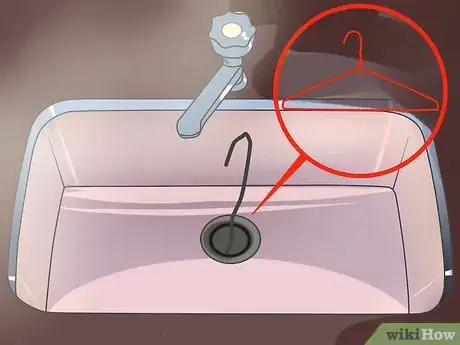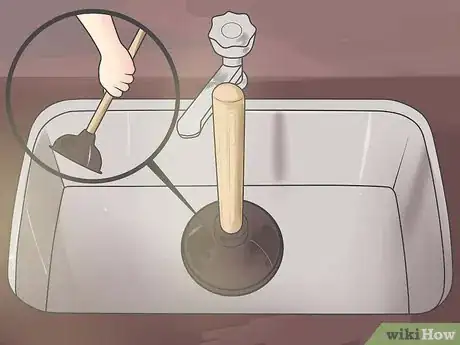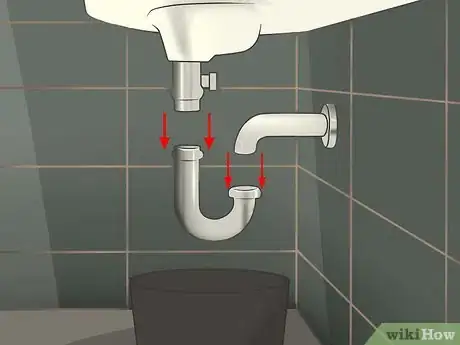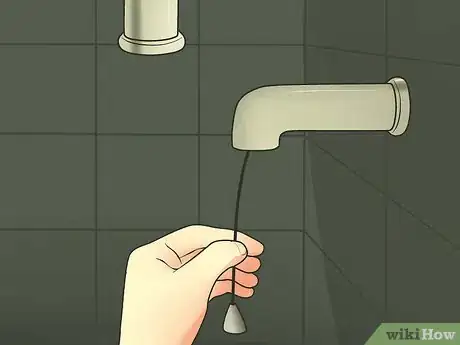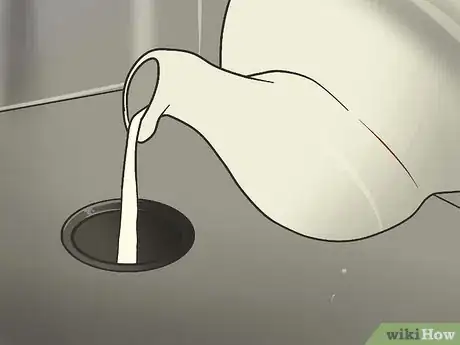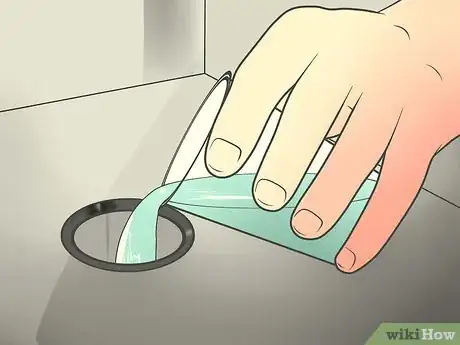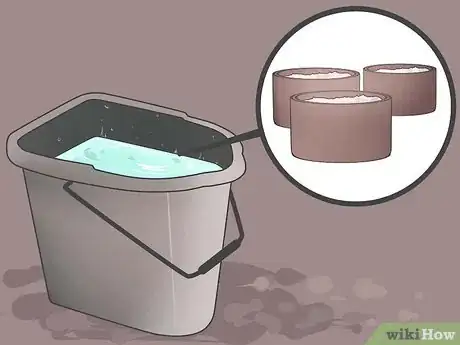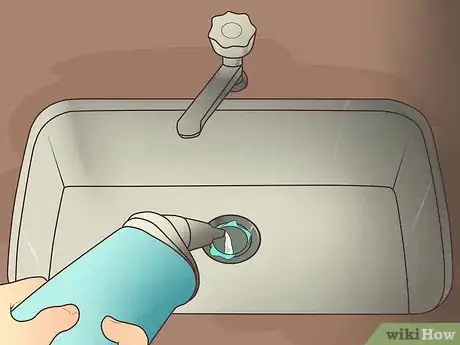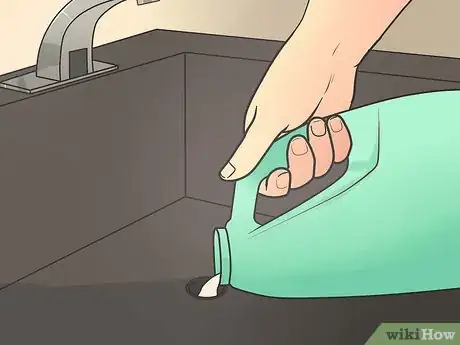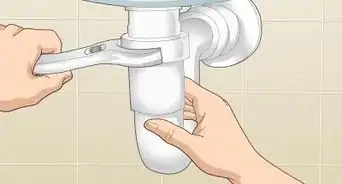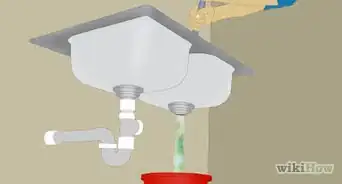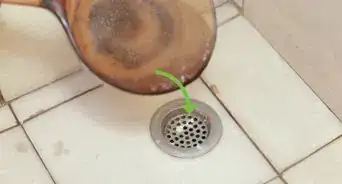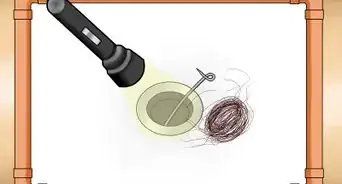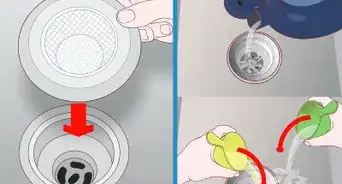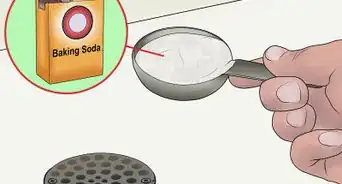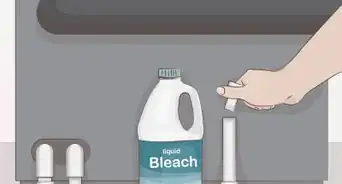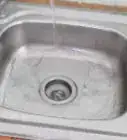This article was co-authored by Allen Lee. Allen Lee is a Home Improvement Specialist and the Owner of Honest Lee Handyman Services, a licensed and insured handyman business servicing Sacramento, California, and surrounding areas. Working with homeowners and businesses to get their small repairs done in a timely and efficient manner, Honest Lee Handyman Services provides gutter and dryer vent cleaning along with fixture, fence, drywall, and toilet repairs.
There are 7 references cited in this article, which can be found at the bottom of the page.
wikiHow marks an article as reader-approved once it receives enough positive feedback. In this case, 89% of readers who voted found the article helpful, earning it our reader-approved status.
This article has been viewed 500,478 times.
A clogged sink can be a major inconvenience, but before you call a plumber, consider unclogging your sink at home. Manual removal works well if you have large clumps of debris jamming up your pipes, but you can also create natural drain cleaners or use chemical cleaners to help rid your sink pipes of unwanted material. Here are the most common methods you should consider trying the next time your sink gets plugged.
Steps
Manual Removal
-
1Clear out the blockage with a bent wire hanger.[1] If you suspect that your sink is clogged with hair or other solid masses, you might be able to fish it out with an old, bent wire hanger.
- Straighten out a wire clothes hanger as much as possible. Bend one end slightly to create a small hook capable of fitting into your sink drain.
- Slide the wire hanger down, hook-side first, into the drain. Try to keep the wire pressed to the side of the drain rather than pushing it down the center of the pipe. Doing so will minimize the risk of pushing the blockage further down.
- Once you feel resistance, twist and maneuver the hanger in an attempt to hook the blockage. Pull the wire back up to remove as much of the blockage as possible.
- Run hot tap water from your sink and into the drain for a couple of minutes. Make the water as hot and rapid as possible, but if the sink starts to back up, turn the water off.
-
2Use a plunger to loosen the clog.[2] Use a standard plunger to vigorously suction the blockage out.
- If you are working with a sink that has two sink drains, hold a wet cloth tightly over one drain to seal it off.
- Place a plunger over the other drain, holding it fairly upright.
- Fill the other side of the sink with 3 to 4 inches (7.5 to 10 cm) of water. Doing so helps the plunger seal around the drain.
- Roll the head of the plunger into the water, forcing water into the drain. Pump the plunger up and down for a solid 20 seconds using a vigorous, rapid motion, but do not break the seal between the plunger and the drain.
- Pop the plunger off the drain on your last vertical upstroke.
- You may need to plunge the sink for several minutes in order to loosen the blockage.
Advertisement -
3Clean the P-trap. The P-trap often catches debris and other blockages before they make it further into your pipes.[3] This portion of your piping is located directly under your sink and can be removed and cleaned out manually.
- Place a large bucket below the trap. This will catch any water or debris that falls from the pipe once you remove the trap.
- Use slip joint pliers to loosen the slip nuts on the trap and unscrew the nuts by hand. Slide the nuts away from the connections and carefully slip off the trap.
- Use a small wire brush to scrap out any debris from the trap, emptying it into the bucket below. Also clean the trap out by scrubbing with the same wire brush.
- Carefully rinse the trap with hot water. You may want to use another sink, since you just removed a portion of the drain pipe for the sink you are currently working on.
- Reattach the trap to the rest of the piping. If any slip nut washers show notable signs of wear, replace them.
-
4Snake the line. If the blockage lies deeper in the sink line, you may need to use a snake to clean it out.[4]
- Remove the P-trap and any pipes that connect to the drain stub-out at the wall.
- Pull out 6 to 10 inches (15 to 25 cm) of snake cable.
- Thread the tip of the snake into the drain stub-out. Tighten the setscrew.
- Turn the crank clockwise to feed it into the pipe. Any initial resistance you feel is likely caused by turns and corners the snake must make.
- Once you hit a blockage, continue cranking until you feel the tip of the snake cable break through to the other side. The tension in the cable will be reduced dramatically after it breaks through.
- Turn the crank counter-clockwise to pull the cable out. Clean the cable as you remove it.
- Repeat as needed until you no longer feel any blockage and restore your piping to its usual state.
Natural Aides
-
1Flush the sink with boiling water. Boil at least 4 cups (1 L) of water in a kettle. After the water boils, pour it down the drain in two to three stages, pausing for several seconds in between each stage. Repeat if needed.
- If possible, flush the sink out with at least 4 cups (1 L) of water. Use more if your kettle will hold it.
- If you do not have a kettle, you can boil the water in a saucepan or electric hot pot.
- You could also use the microwave to boil water, but microwave the water only in 20 to 40 second intervals and keep a wooden chopstick in the water as it microwaves. Otherwise, the water could super-heat and present a danger.
- Pour the boiling water directly down the drain, rather than pouring it into the sink first and letting it gradually flow to the drain.
- Note that this works best on minor clogs and may not prove as effective against heavy clogs. The water must also be boiling as you pour it since the vibration of the water is part of the reason why the remedy is effective at all.
-
2Dissolve the clog with baking soda and vinegar.[5] [6] The baking soda and vinegar solution is highly effective because the fizzy reaction created between the two cleaning products is vigorous and abrasive enough to loosen many stubborn clogs.
- Pour 1/2 cup (125 ml) baking soda down the sink drain.
- Follow the baking soda with 1/2 cup (125 ml) white distilled vinegar.
- Quickly cover the drain opening with a drain stopper. Doing so forces the fizzy reaction down through the pipes, where the blockage is, rather than up and out.
- As soon as the fizzing stops, pour another 1/2 cup (125 ml) white distilled vinegar down the drain. Cover again and let sit for 15 to 30 minutes.
- Boil 1 gallon (4 L) of water in a kettle or saucepan. Pour the boiling water into the sink to flush out any remaining vinegar and baking soda.
-
3Pour salt and baking soda into the drain. When combined, salt, baking soda, and water also create a chemical reaction capable of loosening most blockages.
- Combine 1/2 cup (125 ml) table salt and 1/2 cup (125 ml) baking soda.
- Carefully pour or spoon the combination down the sink drain. Get as much into the drain as possible, and avoid getting too much excess on the basin of the sink. The reaction will only be effective against the blockage if it comes into direct contact with it.
- Let the baking soda and salt sit for 10 to 20 minutes.
- Boil 1 to 4 quarts (1 to 4 L) of water in a kettle or saucepan. Carefully pour the boiling water into the drain.
- Plug up the sink drain as quickly as possible after adding the water to force the reaction down into the pipes rather than up and out.
- The chemical reaction produced should be enough to clear most moderately clogged sinks.
Heavy-Duty Chemical Help
-
1Pour caustic soda down the drain. Caustic soda, or sodium hydroxide, is an extremely strong chemical that will dissolve most blockages clogging up your sink.
- Caustic soda can be purchased at most hardware stores.
- Dilute 3 cups (750 ml) of caustic soda with 3/4 gallon (3 L) of cold water in a large mop bucket. Mix the chemical and the water together with a wooden spoon.
- Do not use any container or utensil you plan to use for food later on.
- Do not stir the water and caustic soda together with your hands.
- The water and caustic soda should begin to "fizz" and heat up as you mix the two together.
- Carefully pour the solution directly into the clogged sink drain. Let sit for 20 to 30 minutes without touching it.
- Boil 1 gallon (4 L) of water on the stove and use it to flush the drain.
- Repeat the procedure if necessary.
-
2Try bleach. If you are connected to a public sewer system and not to a well or septic tank, you can use bleach to both clean and deodorize a clogged sink.
- Pour 1 cup (250 ml) of undiluted bleach directly down the sink drain. Let sit for 5 to 10 minutes.
- Turn your sink on and let water rush into the drain. Make sure that the water is as hot as possible and as strong or rapid as possible. Let it run up to 5 minutes.
- If your sink begins to back up and fill with water, turn the water off and let it drain before attempting to unclog the sink again.
- Do not use bleach if you use a septic tank. Bleach kills bacteria living in the tank, but the bacteria it kills eats solid waste, thereby preventing the lines from clogging.
-
3Use drain cleaner.[7] Commercial drain cleaners can be purchased at most grocery stores, and there are caustic, acid, and enzymatic cleaners available.
- Read the label carefully to determine which cleaner is right for your particular type of blockage. For instance, some cleaners might work better in bathroom sinks, while others might work better for kitchen sinks.
- Follow the instructions on the label carefully when you use it.
- Caustic drain cleaners rely on chemical reactions caused by hydroxide ions.
- Acid drain cleaners use a chemical reaction between hydrogen ions and the material clogging the sink. Acid cleaners tend to be harsher than caustic drain cleaners.
- Enzymatic cleaners are the least potent and rely on bacterial enzymes to eat away organic blockages.
Expert Q&A
Did you know you can get expert answers for this article?
Unlock expert answers by supporting wikiHow
-
QuestionWhat is the best thing to use to unclog a sink?
 Allen LeeAllen Lee is a Home Improvement Specialist and the Owner of Honest Lee Handyman Services, a licensed and insured handyman business servicing Sacramento, California, and surrounding areas. Working with homeowners and businesses to get their small repairs done in a timely and efficient manner, Honest Lee Handyman Services provides gutter and dryer vent cleaning along with fixture, fence, drywall, and toilet repairs.
Allen LeeAllen Lee is a Home Improvement Specialist and the Owner of Honest Lee Handyman Services, a licensed and insured handyman business servicing Sacramento, California, and surrounding areas. Working with homeowners and businesses to get their small repairs done in a timely and efficient manner, Honest Lee Handyman Services provides gutter and dryer vent cleaning along with fixture, fence, drywall, and toilet repairs.
Home Improvement Specialist
Warnings
- Add the caustic soda to the water, never the other way around! If water is added to caustic soda, an exothermic reaction will cause the solution to possibly boil and splash on you, causing serious chemical and thermal burns. Great caution is advised.⧼thumbs_response⧽
- Wear rubber gloves and eye goggles when using heavy-duty chemicals, especially caustic soda and drain cleaner. If any of these chemicals splash onto your skin, wash it off immediately with soap and water. If your skin still tingles or burns after cleaning it, immediately seek medical help.⧼thumbs_response⧽
- If you receive serious injuries while doing this, seek immediately emergency medical help.⧼thumbs_response⧽
Things You'll Need
- Wire clothing hanger
- Rag
- Plunger
- Large bucket
- Slip joint pliers
- Small wire brush
- Snake
- Kettle or saucepan
- Water
- Baking soda
- Vinegar
- Salt
- Caustic soda
- Wooden spoon
- Bleach
- Commercial drain cleaner
- Rubber gloves
- Safety goggles
References
- ↑ http://www.wisebread.com/10-really-easy-ways-to-unclog-drains
- ↑ http://www.familyhandyman.com/DIY-Projects/Plumbing/Plumbing-Tips/how-to-clear-clogged-sink-drains/View-All
- ↑ Allen Lee. Home Improvement Specialist. Expert Interview. 10 July 2020.
- ↑ Allen Lee. Home Improvement Specialist. Expert Interview. 10 July 2020.
- ↑ http://bonzaiaphrodite.com/2009/06/natural-homemade-drain-o-or-how-to-unclog-without-chemicals/
- ↑ http://www.onegoodthingbyjillee.com/2012/09/how-to-unclog-your-kitchen-sink-or-any-other-sink.html
- ↑ http://www.howtocleanstuff.net/how-to-clean-a-kitchen-drain/
- ↑ https://www.apartmenttherapy.com/how-to-unclog-a-bathroom-sink-44368
About This Article
To unclog a sink, try using a plunger to loosen the clog like you would a toilet. Make sure the sink has 3 to 4 inches, or about 7.6 to 10.2 cm, of water so the plunger can create a good seal. Then, holding the plunger upright, plunge vigorously for 20 seconds or until you feel the pressure give way. If that doesn’t help, you can also try pouring boiling water down the drain, which may help loosen up whatever is inside. For really stubborn sinks, combine 1 part baking soda and 1 part vinegar in a glass and pour it down the drain, or use any commercial drain-unclogging product. Let the mixture sit in the drain for 20 minutes before flushing it out with boiling water.
